China’s Records
Wang Ronghua
The World’s Earliest Astronomical Book— 《Star Manual of Masters Gan and Shi》
Master Gan’s name is Gan De (甘德),was born in the 4th century BC in the State of Qi. He made some of the first detailed observations of Jupiter in recorded history. He described the planet as “very large and bright”. Gan De is reported to have seen one of the moons of Jupiter with his naked eye in 364 BC,long before Galileo Galilei's celebrated discovery of the same in 1610.
He wrote two books, the 《Treatise on Jupiter》 and the 8-volumes 《Treatise on Astronomical Astrology》; both of which have been lost. Gan De also wrote the 《Astronomic star observation》
Master Shi’s name is Shi Shen, born in the mid Warring States Period in the city of Kaifeng. He is credited with positioning the 121 stars found in the preserved texts. He also made the earliest surviving undated record of sunspot observation.
His works included the 8-volume Astronomy , the one-volume Celestial Map and the one-volume Star Catalogue of Shi . The latter two are now believed to be written by his school followers. Most of his works did not survive intact, but a few of his crucial writings were preserved in the Treatise on Astrology of the Kaiyuan Era.
The crater Shi Shen on the Moon is named after him.
Ma Xian in circa 579 AD put the books of the two maters together and entitled it 《Star Manual of Masters Gan and Shi》.
The observations and studies of the two masters, and in particular the celestial map is 100-200 years earlier than Greek astronomers Hipparchus(190-125BC),Aristille and Timocharis(both not earlier than the 3rd century BC).
The Earliest, Best Preserved Existing Stone Arch Bridge of the World
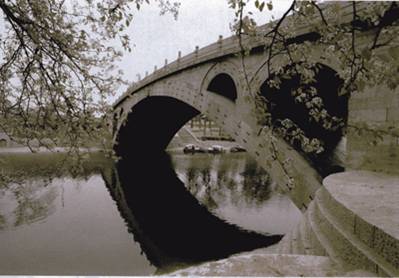
Zhao Zhou Bridge, also known as Anji Bridge is located in the Zhaoxian County, 45 kilo-meters southeast of Shijiazhuang. It was built in the Sui Dynasty (circa 581 AD) and reputed as the first bridge under heaven. The Chief architect was Li Chun. The??bridge is?64.4??meters?long??and its??main?net?span?is?37.02 meters long. It's?theoldest??? best?preserved?single arch?broad?shoulder?stonebridge?existing?in?the?world.Its??special structure?made?it?strong?and elegant.?American?Civil?Engineers?Society?presented?a?copper plate?in 1991 to??? recognize?it?as?one?of??the?international?civil?engineering?landmarks.
Yongle Encyclopedia, the largest and one of the earliest encyclopedia
Yongle Encyclopedia
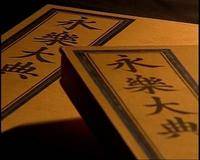
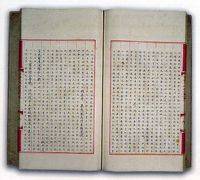
The Yongle Encyclopedia (永乐大典;literally “The Great Canon or Vast Documents of the Yongle Era”) was a Chinese compilation commissioned by the Chinese Ming Dynasty emperor Yongle in 1403 and completed by 1408. It was then the world's largest known general encyclopedia, and one of the earliest.
Yongle Encyclopedia, the largest and one of the earliest encyclopedia
Two thousand scholars worked on the project under the direction of the Yongle Emperor (reigned 1402–1424), incorporating eight thousand texts from ancient times up to the early Ming Dynasty. They covered an array of subjects, including classics, histories, works of philosophers other than the Confucius and collections of poetry and prose, agriculture, art, astronomy, drama, geology, history, literature, medicine, natural sciences, religion, and technology, as well as descriptions of unusual natural events. The Encyclopedia, which was completed in 1408 at Nanjing Guozijian (南京國子監; the ancient Nanjing University - Nanjing Imperial Central College), comprised 22,877 or 22,937 manuscript rolls, or chapters in 11,095 volumes occupying roughly 40 cubic meters (1400 ft3) and using 50 million Chinese characters. It was designed to include all that had ever been written on the Confucian canon, history, philosophy, and the arts and sciences. It was a massive collation of excerpts and works from the mass of Chinese literature and knowledge.
The Largest Collection of Books—A Complete Library of the Four Treasuries
The Siku Quanshu, variously translated as the Imperial Collection of Four, Emperor's Four Treasuries, Complete Library in Four Branches of Literature, or Complete Library of the Four Treasuries, is the largest collection of books in Chinese history and probably the most ambitious editorial enterprise in the history of the world.
During the height of the Qing Dynasty, the Qianlong Emperor commissioned the Siku quanshu; The editorial board included 361 scholars, with Ji Yun (紀昀) and Lu Xixiong (陸錫熊) as chief editors. They began compilation in 1773 and completed it in 1782. The editors collected and annotated over 10,000 manuscripts from the imperial collections and other libraries, destroyed some 3,000 titles, or works, that were considered to be anti-Manchu, and selected 3,461 titles, or works, for inclusion into the Siku quanshu. They were bound in 36,381 volumes (册) with more than 79,000 chapters (卷), comprising about 2.3 million pages, and approximately 800 million Chinese characters.
The Siku quanshu collection is divided into four catagories,
Jing (經 "Classics") Chinese classic texts
Shi (史 "Histories") and geographies from Chinese history
Zi (子 "Masters") philosophy, arts, sciences from Chinese philosophy
Ji (集 "Collections") anthologies from Chinese literature
The books are divided into 44 categories (類), including the Analects of Confucius, Mencius, Great Learning, Doctrine of the Mean, the Book of Change, Rites of Zhou, Classic of Rites, the Book of Songs, Spring and Autumn Annals, Explaining Writing and Decoding Compound of Characters (Shuowen Jiezi), Records of the Grand Historian, Comprehensive Mirror for Aid in Government (Zizhi Tongjian), The Art of War, Talking about Countries (Guoyu), Stratagems of the Warring States, Compendium of Materia Medica, and other classics.
The Siku quanshu collection includes most major Chinese texts, from the ancient Zhou Dynasty to the Qing Dynasty, covering all domains of academia. It is the largest collection of books in the world and contains historically invaluable information.
Pingyao, an Ancient City Remains Intact
Pingyao

Pingyao is an exceptionally well preserved example of a Han Chinese city, founded in the 14th century. Its urban fabric shows the evolution of architectural styles and town planning in Imperial China over 5 centuries. Of special interest are the imposing buildings associated with banking, for which Pingyao was the major center for the whole of China in the 19th and early 20th centuries.
In December 1997, Pingyao was inscribed by UNESCO as a world cultural heritage city.
Inner Look of Pingyao

According to the Chinese legend, it was Emperor Yao’s domain, a county town built for purpose of resisting aggressors during the reign of King Xuan of Western Zhou. Ancestor temples are placed on the left side of the street and social institutions on the right, in total conformity with feudal traditions. There are 3997 courtyard housing in the city, most of them are over 400 years old. The monasteries, office of magistrate, the retail shops, the courtyards and the city wall still look what they were in the Ming and Qing dynasties, thus provides a remarkably complete picture of cultural, social, economic, and religious development during one of the most seminal periods of Chinese history.
Leshan Giant Buddha

Leshan Giant Buddha
Leshan Giant Buddha is one of the most magnificent tourist attractions in Sichuan Province . It's located on the Westside of Xiluan Peak ( Phoenix Perched Peak ) of Mount Lingyun , just east of Leshan City . Overlooking the confluence of the Minjiang, Qingyi and Dadu rivers, the Buddha is carved into the cliffs of Mt. Lingyun . A local saying describes the Buddha like this; "The mountain unveils a Buddha, while the Buddha fades into the mountain."
The huge figure takes the shape of a Maitreya Buddha, a disciple of Sakyamuni, the founder of Buddhism. The figure occupies the entire hillside. Its head reaches the top of the cliffs, his hands rest on his knees and his face has a serene expression as it gazes at Leshan city across the river which rushes past its feet.
Looking solemn and stately, the Buddha is 71 meters high. His shoulders are 28 meters wide, head 14.7 metes long and 10 meters broad, with a total of 1021 chignons of hair clustered on it. Each is as big as a round table. Its drooping ear is 6.2 meters long, its eye 3.3 meters wide. Its middle finger is 8.3 meters long, and each of its bare feet are 11 meters long and 8.5 meters wide, large enough for more than 100 people to sit on.
In 1996, it was added to the World Natural and Cultural Heritage List.
According to records, the carving of this massive statue began in 713AD, during the Tang dynasty, and took 90 years to complete, finally being finished in 803AD.
The Art of War—the Earliest Military Classic
The Art of War
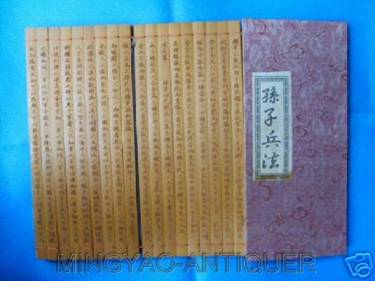
This oldest existing military classic was written by Sun Wu of the State of Qi around the year 476 BC. Sun came to the State of Wu and presented his book to He Lǚ, the King of Wu who appointed him a general, he used his theory and successfully took Ying, the capital of Chu, thus destroyed the State of Chu.
There are 13 chapters in the book.
“Laying Plans” talks about comparing conditions with the enemy, estimating possibilities of winning and making plans accordingly;
“War Waging” deals with mobilization;
“Attack by Stratagem” expounds the attack is to break the enemy’s resisting without fighting;
“Tactical dispositions and energy” deals with two decisive factors to war. Tactical dispositions refer to objective, stable and obvious factors such as strength and material preparation; energy refers to subjective, changeable and accidental factors, such as morale and collocation of forces.
“Being weak or strong” explains how to grasp a supreme hand by dispersing or concentrating troops; encompassing or going around the enemy.
“Maneuvering” deals with how to get the first opportunity to attack;
“9 variations” refers to different tactics to be taken for different situations;
“On the march” tells how to observe the enemy when stopping or on the road;
“Terrains” offers 6 tactics for different terrains;
“9 situations” analyzes 9 situations and tactics each requires;
“Fire attack” explains attack by fire;
“Use of spies” explains how to use five kinds of spy for winning the war.
《Spring and Autumn》--China’s Earliest Chronicle Historic Book
《Spring and Autumn》 is China’s first chronicle historic book compiled by Confucius. The histories of duke state of Eastern Zhou have lost, only that of Lu survived thanks to Confucius who, after traveled for 14 years to other states and returned to Lu at the age of 68, began to compile and edit the history of Lu.
The book recorded the affairs 12 dukes of Lu conducted in a span of 242 years starting from the first year of Duke Yin in 722 BC to the 14th year of Duke Ai in 481 BC; it also included changes in other states;
The existing version of the book contains only 16,000 characters, Confucius took the compiling very personal and regarded it as his second life. In the book he used sublime words to give deep meanings, and mainly criticized those who named themselves kings when they should be dukes only.
“Di Bao”—News Dispatch for Chanceries, China’s Earliest Newspaper
“Di Bao” is China’s earliest newspaper, which appeared in the initial period of Western Han (circa 200 BC). The country was divided into prefectures, each prefecture had an office in the capital, such an office was called “Di-Chancery”, which was used to house permanent representatives of prefectures, and their mission was to pass imperial edicts, orders and rescript, what ministers had appealed to the emperor and major events happened in the capital to the head of prefectures.
A sample of “Di Bao”
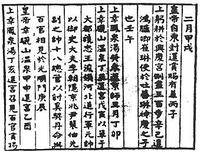
Such information was written on bamboo slips or pieces of silk to be carried by couriers on horses on the roads for posts.
Ever since Han, the name of “Di Bao” had changed many times, yet, the distribution had never broken up, its nature and content remained more or less the same through the dynasties of Tang, Song, Yuan, Ming and Qing.
Kangxi Dictionary that collected Most Chinese Characters
A photo of the 2005 re-print
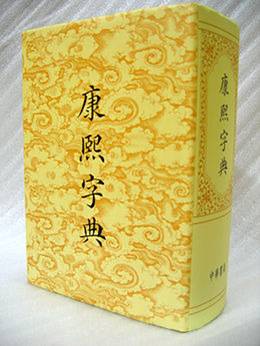
The Kangxi Dictionary was the standard Chinese dictionary during the 18th and 19th centuries. The Kangxi Emperor of the Qing Dynasty ordered its compilation in 1710 and it was published in 1716. The dictionary is named after the Emperor's era name.
Although the dictionary contains over some 47,000 characters (including obscure, variant, rare, and archaic characters), less than a quarter of these characters are now commonly used.
The Kangxi Dictionary editors, including Zhang Yushu (張玉書) and Chen Tingjing (陳廷敬), partly based it on two Ming Dynasty dictionaries: the 1615 Zihui (字彙 "Character Collection") by Mei Yingzuo (梅膺祚), and the 1627 Zhengzitong (正字通 "Correct Character Mastery") by Zhang Zilie (張自烈).
The supplemented dictionary contains 47,035 character entries, plus 1,995 graphic variants, giving a total of 49,030 different characters. They are grouped under the 214 radicals and arranged by the number of additional strokes in the character. Although these 214 radicals were first used in the Zihui, due to the popularity of the Kangxi Dictionary they are known as Kangxi radicals and remain in modern usage as a method to categorize traditional Chinese characters.
The Kangxi Dictionary editors, including Zhang Yushu (張玉書) and Chen Tingjing (陳廷敬), partly based it on two Ming Dynasty dictionaries: the 1615 Zihui (字彙 "Character Collection") by Mei Yingzuo (梅膺祚), and the 1627 Zhengzitong (正字通 "Correct Character Mastery") by Zhang Zilie (張自烈).
The supplemented dictionary contains 47,035 character entries, plus 1,995 graphic variants, giving a total of 49,030 different characters. They are grouped under the 214 radicals and arranged by the number of additional strokes in the character. Although these 214 radicals were first used in the Zihui, due to the popularity of the Kangxi Dictionary they are known as Kangxi radicals and remain in modern usage as a method to categorize traditional Chinese characters.
